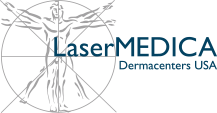What is Photorejuvenation?
Photorejuvenation uses a series of Intense Pulsed Light (IPL) treatments at a frequency that targets pigmented cells. The light passes harmlessly through the skin and is absorbed by spots and lesions. The abnormal cells are destroyed, leaving only healthy tissue. IPL also stimulates the growth of collagen, fills in acne scars, decreases pore size and gives skin a youthful appearance.
What does the treatment entail?
The skin is cleansed, prepared with gel and then treated with the light. Afterwards, the gel is cleaned off and replaced with sunscreen. Cold compresses may be used if needed.
What are the benefits of Photorejuvenation?
Photorejuvenation’s short treatment time, quick effects and lack of downtime make it popular. Photorejuvenation gives skin a healthy, youthful look and decreases the appearance of blemishes such as acne scars, brown spots and redness from rosacea.
How many treatments are required?
The standard treatment is a series of three to five treatments performed at three to four week intervals. Some may be satisfied with the results from tow or three sessions, and some may desire additional sessions.
Is Photorejuvenation safe?
Photorejuvenation is a safe, common and quick procedure with little risk.
Are there any possible side effects?
You may experience a sunburned look for a few hours after treatment, and targeted spots will temporarily appear darker and flake off in a couple of days. Hair growth may be affected. Swelling, blistering, infection, unwanted pigmentation changes and scarring are rare side effects. Existing viral infections such as shingles and herpes may be activated by the treatment.
What conditions respond best to this treatment?
Rosacea, age spots, enlarged pores, freckles and sun spots all respond well to Photorejuvenation.
Will there be any downtime?
No, you may immediately return to your normal routine and even apply makeup.
What can be expected post-treatment?
Your skin will be sensitive and will need to be protected from the sun. Any swelling will be minimal and can be treated with cold compresses. Dark spots from the treatment should flake off after a few days.
How soon will results appear?
Noticeable results appear after the first few treatments.
How long does a Photorejuvenation treatment last?
A session lasts about a half an hour.
Who should avoid Photorejuvenation?
You may want to reconsider having Photorejuvenation if you have a history of excessive scarring, bleeding or bruising, sun sensitivity, keloid formation or poor healing. Those with a family history of skin cancer should talk to a specialist about whether or not to proceed with Photorejuvenation.
How does the treatment feel?
You will experience some discomfort. Most find the treatment to be similar to the sensation of a rubber band snapping against the skin.
How long do the results last?
The effects of Photorejuvenation can be permanent if the skin is well cared for.
What are the alternative treatments?
There are other light treatments and topical creams that may be used instead. You should consult a specialist, as Photorejuvenation will not treat the underlying conditions causing your problem areas.
What are the limitations of Photorejuvenation?
Those with darker skin are less likely to see results and more likely to experience adverse side effects.
Instructions for before treatment:
Discontinue use of Accutane® for six months, Retin-A® for two weeks and glycolic acid and alpha-hydroxy acid products for a week before your treatment. Avoid sun and sunless tanning for four weeks. Do not take aspirin or other blood thinners for at least three days before your treatment. You cannot be treated while you have infections or sores in the area.
Instructions for after treatment:
Protect your skin with moisturizers and sunscreen. Cold compresses and steroid creams may be used as necessary. Avoid irritating your skin, and keep away from the sun and sunless tanners for a couple of weeks.
